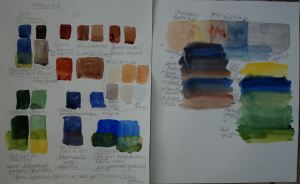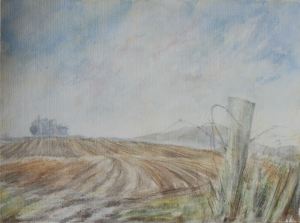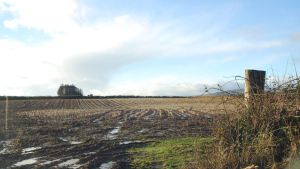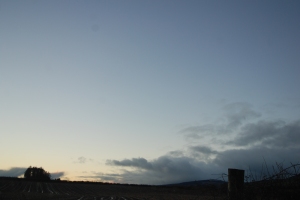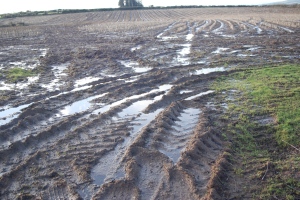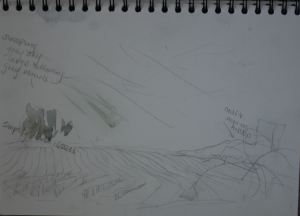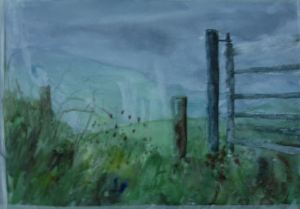As a slight adaptation to the study I decided to concentrate on the scene during a brighter moment of my visit, using as reference three of my photographs, sketches and colour study. I think this was because the sun was shining at this time, from behind the trees to the left, hence creating more contrast of light and darks and I was interested at the time in trying to capture the group of tall trees in silhouette on the horizon/skyline and the sunlight falling on the field and fence post in the foreground. It also came with a bluer sky and lighter clouds.
However during the later stages I started to to realize, when I stood back from the painting that in my efforts to obtain accurate perspective in the field’s crop lines to give a sense of depth and expansive landscape, the painting was starting to tighten up. I put a lot of time in to thinking about how best to approach this part of the scene and into practicing most of the techniques but perhaps I thought about it too much. Whereas in my painted study, although it was done much quicker and spontaneously, i had considered and reserved the lighter areas of the field ie. the lines of straw stubble, applying them quite quickly and roughly using white wax crayon. I thought that while it did the job in one sense, it looked too light and too obvious and I was looking for something still effective but more subtle yet effectively convincing. On looking back at my initial rough notes, I noticed I had told myself not to overdo the details in the land as there is a lot of sky, somewhere along the line I seem to have lost sight of this. All in all, comparing the study and the final painting from a distance my preference would be for the study with a few minor adjustments. This is the trap I so often seem to fall into when it comes to assignments. My tutor did make suggestions to approach the assignment piece almost as though it is a study and I intended to take this on board. I know what I should be doing deep down, but somehow I allow a demon to take over and the rest is downhill. Perhaps I will try at least another version.
The first version above, received a more drastic washing off than the second one and is even more faded out. But I also think because of the different paper that the paint didn’t soak in to it to the same extent. Perhaps also some of the colours don’t have as much staining ability as those in the second painting below. Again I think some parts of it would benefit from a little selective strengthening.
So, I did go on to do just that while thinking I must approach this one in the same spirit as the study, also giving myself a time limit of an hour, the idea being that this would lessen the risk of spoiling it. In the end it took an hour and a half but this was less than half the time it took to do the previous one.
Going to the other extreme of paper texture, I used Fabriano HP (smooth) this time. Looking at a few watercolour landscape studies of Turner’s also gave me some inspiration, the sky particularly. I am happier this time with the second attempt, it is a looser composition and I prefer the colours. Also, the sky and light have changed dramatically – rain clouds are looming over in the distance behind the clump of trees and the landscape is darker. I also lightened the trees and midground as I think they look too hard and dominant in the other version. The white wax crayon again came in handy to resist the paint in the lines of field stubble. I previously tried out a pale brown/orange wax crayon for this but the lines didn’t seem to show adequately, even when I practiced using dark paint over it. I didn’t have any photos of the scene in front of me for this one, I think there may be a message there for me…. However I still prefer aspects of the study such as the trees and mid foreground – they look more spontaneous than either of the two finished paintings, which is I guess, going to be inevitable to some extent, although I think I have come closer to it in the second version. I am pleased that this one seems to a certain bleakness of the landscape, giving a sense of an atmosphere common in Ireland during the winter.
 Above = second version after washing off
Above = second version after washing off
The whole thing is more faded out after running under the shower and I think perhaps small parts of the foreground could be selectively strengthened. I do like that many of the thin wispy lines of tall grasses and brambles around the fence post still look relatively prominent, even those done with watercolour and the ones scratched into the paper are very dark.

